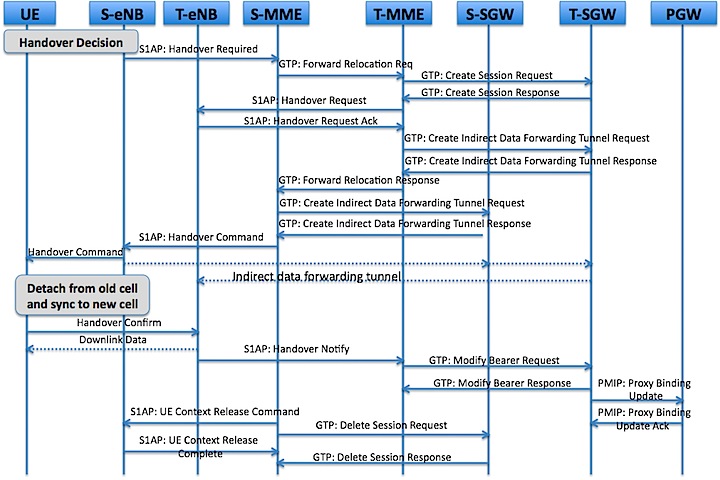LTE - Indirect Tunnel during Handover
来源:互联网 发布:javascript视频下载 编辑:程序博客网 时间:2024/05/17 01:22
哎。搬运工。。。有什么好屏蔽的么。
http://wired-n-wireless.blogspot.com/2010/11/lte-indirect-tunnel-during-handover.html
LTE is a high speed network with an assumption of always on connectivity to packet data network even when UE is moving at high speeds. So during the handovers it is assumed there is no packet loss. But when UE is moving from source network to target network, there is definitely a connection break and make. While the connection is broken and again made at target network, the data to UE is buffered at the source eNB and forwarded to target eNB once the handover is complete. If there is a direct link between source and target eNB then data buffered at the source eNB will sent over it to target eNB. Else indirect tunnel will be used . Below figure shows S1 Handover with SGW Relocation when Indirect Tunnel is used.

This post specifically concentrates on how the buffered data will flow in case of indirect tunnel.Cristina in her blog has very clearly written about this, but I would like to make rather simple explanation

- Source eNB buffered packets to Source SGW over UL TEID that source SGW sent.
- Source SGW sends packets to target SGW over DL TEID that target SGW has sent to MME, which was forwarded to source SGW.
- Target SGW sends packets to target eNB over DL TEID that target eNB has been sent to MME which was sent to target SGW.
- LTE - Indirect Tunnel during Handover
- LTE Handover Overview
- Intra-LTE Handover : X2 based handover
- Intra-LTE Handover : S1 based Handover
- LTE S1 Handover过程中信息交互
- Tunnel ID in the LTE
- 16-EMM Procedure 6. Handover without TAU - Part 1. Overview of LTE Handover
- how to understand TSs – S1 handover with MME and SGW relocation and Indirect Tunneling
- how to understand TSs – S1 handover with MME and SGW relocation and Indirect Tunneling
- 无线网络-LTE (10) 通信过程之 HO - X2-based handover without Serving GW relocation
- zoj1045-HandOver
- tunnel
- INDIRECT函数
- Excel INDIRECT
- LTE
- LTE
- LTE
- LTE
- 标准的好处及其他
- iOS5上可以在一侧放置多个button了~~
- Ubuntu下VIM个性设置
- 如何对单个文件进行简单的zip压缩
- XML文件格式语法及DTD
- LTE - Indirect Tunnel during Handover
- Nginx配置文件说明
- 一页纸说清战略
- xml文件解析办法
- 最好的5个基于PHP的开源电子商务系统比较和评价
- 反向代理及Nginx示例
- 寻找数组中过半的数
- (转)Cache的地址映射与转换
- 从程序员到技术总监,分享10年开发经验


